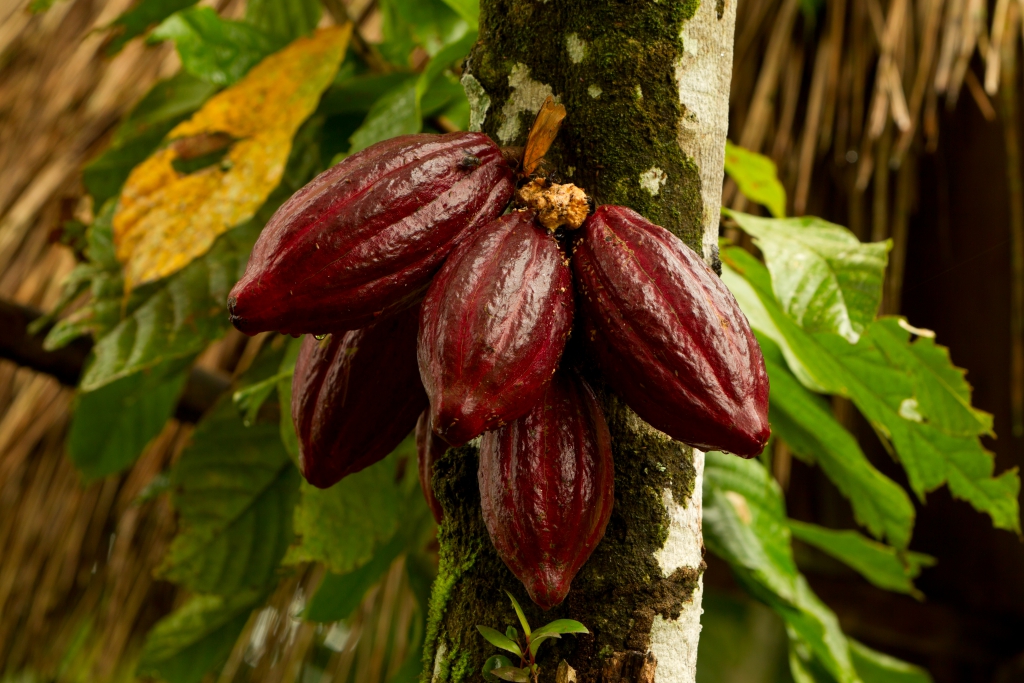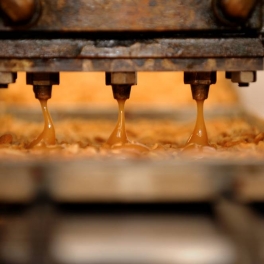1. Plantations
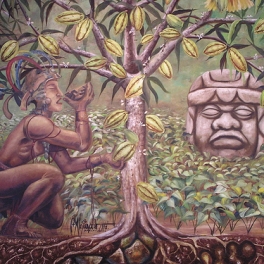 According to botanists, cocoa trees have been growing wildly already in a year 4000 BC, around the Amazonian river. Mayans were probably the first to start growing cocoa trees and process cocoa beans to prepare the energizing drink.
According to botanists, cocoa trees have been growing wildly already in a year 4000 BC, around the Amazonian river. Mayans were probably the first to start growing cocoa trees and process cocoa beans to prepare the energizing drink.
The conditions at plantations are the same as in a natural forest. Tall trees create shades by which they protect cocoa trees from direct sunlight and high temperatures which would destroy cocoa trees. However, their natural environment is tropical with temperatures between 20 and 30°C.The ideal altitude is approximately 400 meters.
In the present, cocoa is being grown in 45 different countries worldwide. Total world production is around 3 million, from which 65-70% comes from Africa – specifically Ivory Coast, Ghana, Nigeria, and Cameroon. 12-13% comes from Latin America – Columbia, Ecuador, Brazil, Mexico, Guatemala, Peru, Cuba, Haiti, and Dominican Republic. The remaining 17% is from South-East Asia: Indonesia, Malaysia, and New Guinea.
2. Plants and flowers
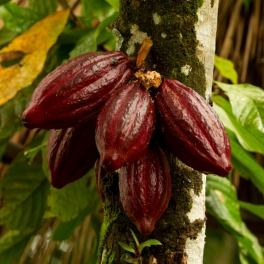 Every year, thousands of small white and yellow-pink flowers bloom beautifully on the cocoa trees. Many of them fade and wither though. Only 1% of these flowers eventually become a fruit – cocoa pod, which grows right on the tree trunk and its main branches.
Every year, thousands of small white and yellow-pink flowers bloom beautifully on the cocoa trees. Many of them fade and wither though. Only 1% of these flowers eventually become a fruit – cocoa pod, which grows right on the tree trunk and its main branches.
There are 3 types of cocoa:
CRIOLLO is a type which produces a very delicate kind of cocoa. Originally, it comes from Central America and Mexico. It is the most valuable type – its fresh beans are of white color, the plants are very gentle and sensitive. This type represents more than 2% of total world production of cocoa.
FORASTERO has violet seeds and green cocoa pods which then change color to yellow and pink when they´re ripe. Their origin is in Amazonia and accounts for approximately 80% of total world production.
TRINITARIO is a hybrid of the preceding 2 types. It originated in Trinidad and represents 18% of total world production of cocoa.
3. Harvesting and fermentation
 Cocoa pods are harvested by hand with a maximum care. The tree with fruits growing on it becomes fully mature after 6 years and is capable of producing up to 80 cocoa pods yearly fro about 40 years.
Cocoa pods are harvested by hand with a maximum care. The tree with fruits growing on it becomes fully mature after 6 years and is capable of producing up to 80 cocoa pods yearly fro about 40 years.
The yield per hectare only rarely exceeds 1000 kg of cocoa beans. For that reason, it is necessary to have enough experience and skills to cut off cocoa pods the right way so that the beans inside won´t get damaged.
Every pod, about 15-20 cm long, contains approximately 30-40 seeds and is rich in sweet wood pulps. The beans and chippings get extracted from pods, then they get collected into boxes, traditionally into banana leafs and they are left to mature for 5-6 days.
During this season, a series of fermentation processes begin: Firstly it´s alcohol fermentation, then milk and vinegar fermentation. It has 3 important functions: Removal of wood pulp, prevention of germination of cocoa pods, and creation of predecessors of aromas – those elements which determine aroma, taste, real value, and complexity of good chocolate during the next phases (roasting, conching, etc.)
4. Dehydration and quality control
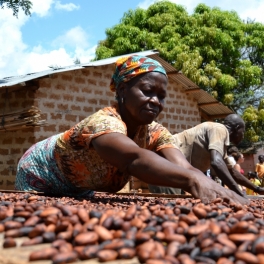 After fermentation, the beans are dehydrated on direct sunlight for 10-12 days, while they´re losing water volume, originally about 7%. This process enables cocoa benas to be stored for very long periods of time. Dehydration is also very important in order to stop the fermentation process. If it takes too long, it may cause an excessive acidity level which would result in decrease in cocoa quality.
After fermentation, the beans are dehydrated on direct sunlight for 10-12 days, while they´re losing water volume, originally about 7%. This process enables cocoa benas to be stored for very long periods of time. Dehydration is also very important in order to stop the fermentation process. If it takes too long, it may cause an excessive acidity level which would result in decrease in cocoa quality.
As well as any other valuable product, cocoa beans need to undergo a very rigid quality control, performed in growers´ processing factories. Subsequently, the cocoa beans are packed into jute bags and are shipped to a “place of destination.” In chocolate-processing factories, the cocoa beans are stored in stacks where the chocolate production process begins.
5. Production of cocoa mass
Cleaning (1)
Cocoa beans are cleaned and possible foreign bodies are removed. If found, damaged and torn seeds are separated, and only whole seeds continue the process.
Pre-roasting (2)
The whole beans undergo a heavy radiation at a level approximately 400°C for about 100 seconds. This temperature makes it easier to remove peelings.
Crushing (3)
The beans are subsequently crushed into small pieces and the peelings re removed.
Alkalization (4)
The seeds go through a free bath, sometimes with added potassium carbonate when needed to decrease the natural acidity of cocoa.
Roasting (5)
The seeds are roasted by hot air at a temperature between 100 and 120°C. This process lasts about 30 minutes. It is extremely important to ensure that seeds are being roasted evenly so that the finest cocoa aroma develops.
Grinding (6)
The seeds are grinded in a special mill to create cocoa mass containing cocoa butter.
6. Production of cocoa butter and powder
Molding
Cocoa mass is pressed in a hydraulic machine which extracts fat and cocoa butter. The dry part of it which remains after molding of cocoa mass is called a pressed cake.
Filtration
Cocoa butter is filtered using paper filters which retain all the dirt and unwanted particles.
Dezodoration
Cocoa butter undergoes a process of dezodoration. A part of volatile acids is extracted by high-pressure steam nozzle, by which we get a sweeter cocoa butter with a less of a sour taste.
Grinding
The pressed cake first gets grinded and then smoothly milled to create a powder. After this phase, it is ready to be packed and distributed.
7. Chocolate production
Mixing
Ingredients are mixed according to the particular recipe and the type of chocolate required – milk chocolate, white, or dark one.
Refining
Big drums grind and cut chocolate paste to gain particles of a required size – approximately 18 microns.
Conching
This process lasts a few hours and serves a few purposes:
- It creates the finest types of chocolate
- It decreases acidity
- It extracts the remaining moisture
In this phase, a small amount of soy lecithin and various flavors are usually added.
Simmering
Before the chocolate is poured into mold, it undergoes a heat treatment when the chocolate gets cooled to 26-28°C and subsequently is heated to 29-32°C. This process is important for cocoa butter to stiffen in a stable crystallized form. Chocolate created this way is shiny, firm, and it has excellent storing features.
Shaping
Chocolate is poured into special molds of different shapes (bars, pralines, chocolate eggs) and gets solidified in big cooling tunnels to ensure easy removal from molds.
Packing
Solid chocolate gets packed the most interesting and most attractive ways for our pleasure.
by Katarína Vicová

